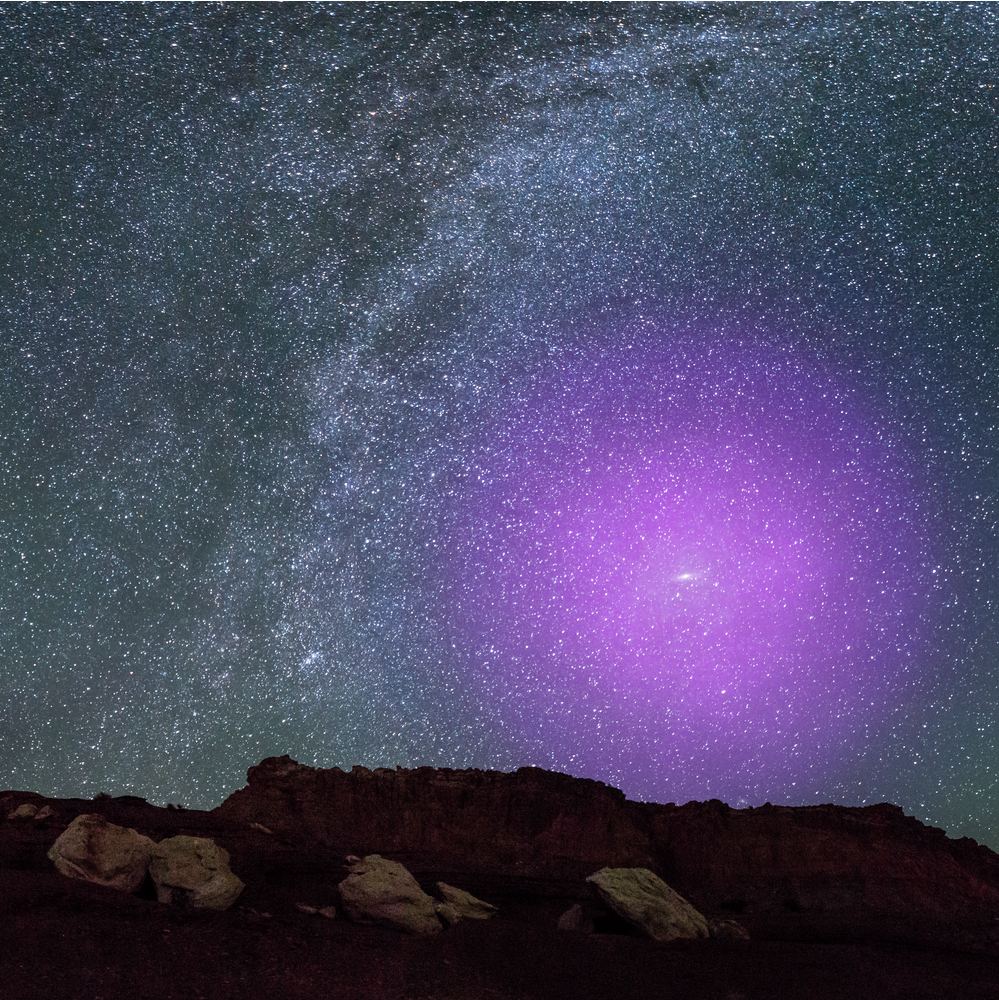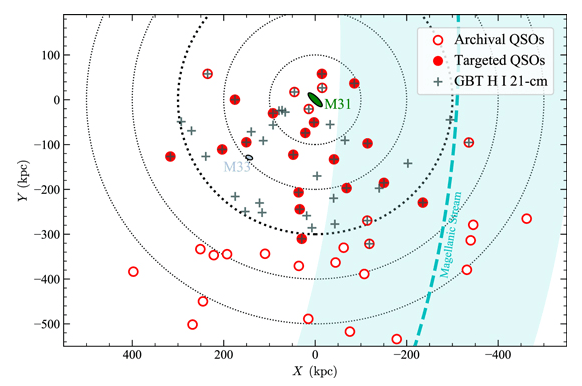It's possible that you've seen the Andromeda galaxy (M31) without even realizing it. The massive spiral galaxy appears as a grey, spindle-shaped blob in the night sky, visible with the naked eye in the right conditions. It's the nearest major galaxy to ours, and astronomers have studied it a lot.
Now astronomers have used the Hubble Space Telescope to map out Andromeda's enormous halo of hot gas.
Scientists call the halo of gas surrounding galaxies the circumgalactic medium (CGM.) The CGM is diffuse, and nearly invisible. But as scientists get the technology to study it more closely, they're starting to understand the important role it plays in galactic evolution. They think that the CGM is an important source of star-forming material, and that it regulates a galaxy's gas supply.
"It’s full of clues regarding the past and future evolution of the galaxy, and we’re finally able to study it in great detail in our closest galactic neighbor."co-investigator Samantha Berek of Yale University in New Haven, Connecticut.
In a new study, a team of researchers used the Cosmic Origins Spectrograph (COS) on the Hubble Space Telescope (HST) to map out Andromeda's CGM. The title of the study is " Project AMIGA: The Circumgalactic Medium of Andromeda. " The lead author is Nicolas Lehner from the University of Notre Dame in Indiana. The study is published in The Astrophysical Journal.
The study shows that Andromeda's halo is by far the largest object in the night sky, we just can't see it. It extends 1.3 million light years from the center of Andromeda, which is about halfway to our galaxy. In some directions, it extends even further, up to 2 million light years. And Andromeda's halo is actually bumping into the Milky Way's halo.
There's also much more detail in the CGM than researchers thought. There are two layered parts to it: an inner shell of gas is nested inside an outer shell. The inner shell is more dynamic, and the outer shell is hotter and smoother. The team of researchers thinks that the inner shell is more dynamic and turbulent because of outflows from supernovae.
"We find the inner shell that extends to about a half million light-years is far more complex and dynamic," explained study leader Nicolas Lehner of the University of Notre Dame in Indiana. "The outer shell is smoother and hotter. This difference is a likely result from the impact of supernova activity in the galaxy's disk more directly affecting the inner halo," Lehner said in a press release.
It's not just the dynamic state of the inner halo that points to supernovae. It's also the composition of the gas itself. The team discovered a lot of heavier elements in the gas, which are created in the hearts of massive stars, and are spread out into space by exploding supernovae.
The gas in the CGM emits some energy on its own, but it's extremely difficult to see. The researchers studied it by watching the ultraviolet light from distant quasars as it passes through the halo. That ultraviolet light is absorbed by Earth's atmosphere, so it can't be observed from the ground. But the Hubble can see it from its position in Low-Earth Orbit (LEO.)
The team found 43 quasars that are "behind" Andromeda from our point of view. Since they're scattered across the breadth and width of the galaxy, the researchers were able to study the halo in multiple locations. They observed how the ultraviolet light from the distant quasars was absorbed differently in different regions of the CGM. The team used Hubble's COS to detect ionized gas from carbon, silicon and oxygen.
This isn't the first time that lead researcher Lehner has studied Andromeda by observing the light from distant quasars. In 2015 he and his colleagues published a pilot study of Andromeda based on the light from only six quasars. That study showed how large and massive Andromeda's CGM is, but it didn't reveal all of the complexity. That work was called " Evidence for a Massive, Extended Circumgalactic Medium Around the Andromeda Galaxy " and was also published in The Astrophysical Journal.
"Previously, there was very little information—only six quasars—within 1 million light-years of the galaxy. This new program provides much more information on this inner region of Andromeda's halo," explained co-investigator J. Christopher Howk, of Notre Dame. "Probing gas within this radius is important, as it represents something of a gravitational sphere of influence for Andromeda."
The team also measured the velocity of the gas in the inner and outer haloes. That's how they determined that the inner shell is more dynamic than the outer shell. The inner shell shows multiple velocity components, while the outer shell shows only one velocity component. The velocity measurements also allowed them to determine that the outer halo is gravitationally bound to Andromeda.
"This is groundbreaking for capturing the complexity of a galaxy halo beyond our own Milky Way."Study Leader Nicolas Lehner of the University of Notre Dame in Indiana.
"Understanding the huge halos of gas surrounding galaxies is immensely important," explained co-investigator Samantha Berek of Yale University in New Haven, Connecticut. "This reservoir of gas contains fuel for future star formation within the galaxy, as well as outflows from events such as supernovae. It's full of clues regarding the past and future evolution of the galaxy, and we're finally able to study it in great detail in our closest galactic neighbor."
Andromeda is really our only opportunity to study a CGM in such detail. Our position inside the Milky Way makes it impossible to study the Milky Way's own CGM. And no other large galaxy is close enough for our current technology to study in this way. Distant galaxies appear so small that there aren't enough background quasars for spectroscopy. Each quasar behind a galaxy provides a sight line for scientists.
"This is truly a unique experiment because only with Andromeda do we have information on its halo along not only one or two sightlines, but over 40," explained Lehner. "This is groundbreaking for capturing the complexity of a galaxy halo beyond our own Milky Way."
Even though we can't study the Milky Way's CGM directly, the researchers say that they can infer certain properties of it based on this study. In their study they write "it is likely that the MW has similarly a cool and warm–hot ionized CGM," and that the Milky Way's and Andromeda's CGM "must most likely already overlap and interact with each other."
As it stands right now, Andromeda is the only galaxy that can be scrutinized in this way. But in the future, that will change. Future UV space telescopes like LUVOIR (Large UV/Optical/IR Surveyor), with its enormous 15m mirror, should allow scientists to study the CGMs of galaxies outside our Local Group. In that sense, this study is giving us a glimpse of some potential future results.
"So Project AMIGA has also given us a glimpse of the future," said Lehner.
 Universe Today
Universe Today



